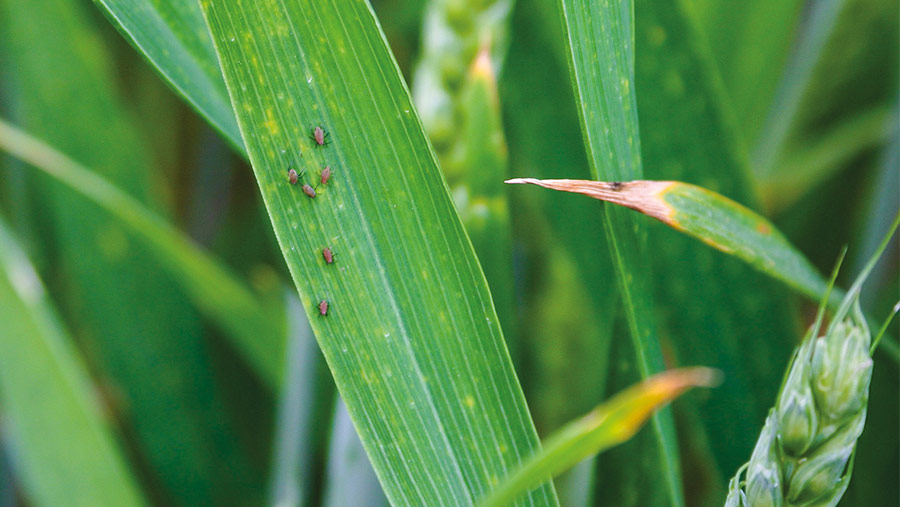4 tips to monitor insect populations to aid pest management
 © Martyn Cox
© Martyn Cox Identifying and monitoring insect populations can benefit growers, providing them with knowledge of the abundance of species on farm so a pest management system can be integrated.
Mark Ramsden, senior consultant and entomologist at Adas, offers his four top tips for measuring insect populations, and what farmers can gain from taking part in investigations.
See also: Is bruchid beetle making spring beans less attractive?
He highlights how monitoring gives growers a firm understanding of what is going on in their fields, which can promote more accurate insecticide applications and also provide them with confidence to cut back on sprays.
“In biology, we know that everything varies. If we were to treat all fields exactly the same, we would expect a large variation in the number and types of insects we find, which makes monitoring so important,” he says.
1. Use insect forecasts
Mr Ramsden’s first tip is to use forecasts and predictions of when insects are likely to be arriving in crops in specific regions. This means growers are prepared for potential infestations so attacks can be dealt with appropriately.
“Forecasts are incredibly useful as they are quick and effective to use, and growers don’t even need to go out into the crop to generate an answer. This means they can be carried out frequently with relatively low effort,” he points out.
He adds that as agriculture moves into a more digital age, lots of funding is being invested into forecasting research and this will see a greater number of forecasting tools and technologies on offer to growers over the next few years.
2. Observe and identify
Once you have an idea of what insects are arriving on farm, further in-field investigations are required. A range of traps can be used to catch pests in order to identify their species. These consist of pitfall traps, water traps, sticky traps and large nets that can catch the insects flying past.
“I really encourage everyone to have a go and see what they can find. The most important thing to do is to have a go at identifying insects, so you can familiarise yourself with the insects present on your farm,” adds Mr Ramsden.
He admits that it doesn’t really matter where you are looking precisely, as long as you are giving it a go.
3. Monitor insects
Monitoring forms the core of an integrated pest management strategy, which involves recording field specific details such as where, what and how many insects are present.
Farmers should think about what it is they want to achieve when monitoring different insects, and how this can help minimise expenditure in terms of time, pesticides inputs and maximising crop yields.
“It’s all about minimising the amount of pesticides applied, not necessarily cutting it down to zero, but only applying what is required in accordance to the number of pests seen in a crop.”
When sampling, a traditional transect should be placed across the field in a “W” formation to incorporate both the edges and centre of field, and everything in-between.
“Aim for as many monitoring points as you can, somewhere between 10 and 15 is good, or even up to 30 can be used,” he says.
Remember that you are trying to record a representative sample of the whole field, and that you should not be focusing on just one patch of the field, as pests are usually located in isolated patches.
Mr Ramsden also points out that the timing of insect monitoring is key and should take place at specific time periods for different pests throughout the season, depending on their life-cycle and when they attack crops.
When to monitor and identify specific pests |
||
| Pest | When to look | What to look for |
| Cabbage stem flea beetle | Emergence to spring | Percentage leaf area eaten |
| Autumn aphids | October to December | Presence/absence |
| Bean weevil | February to end of emergence | Presence/absence of notching |
| Pollen beetle | Feb to April | Beetles per plant/sq m |
| Pod midge | During flowering | Presence of cabbage seed weevil |
| Bruchid beetle | During flowering | Presence/absence |
| Summer aphids | May to July | Percentage tillers with aphids |
| Orange blossom midge | May to July | Trapping results |
| Slugs | Prior to cultivation | Number of slugs/trap |
4. Compare and share
Once data is recorded, information can be analysed to see what areas within a field have certain insects and why. So far, monitoring research has shown that natural enemy populations begin to drop off significantly after about an 80m length into a field.
This data can then be compared against other crops and fields, where it can be shared beyond the farm gate, to build-up a bigger picture of what is going on at a regional or national level.
The eight principles of integrated pest management
- Suppression of pest firstly by non-chemical control
- Pests must be monitored
- Monitoring should guide regional specific use
- Satisfactory non-chemical methods must be preferred
- Pesticides should be targeted
- Keep the use of pesticides to levels that are necessary
- Anti-resistance strategies should be applied
- Monitor the success of the applied protection measures

